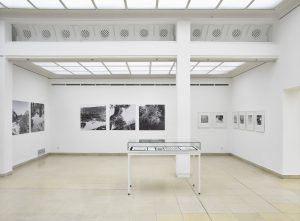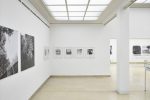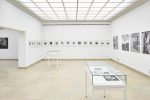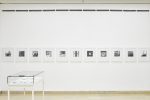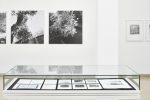quote, unquote
Zita Oberwalder
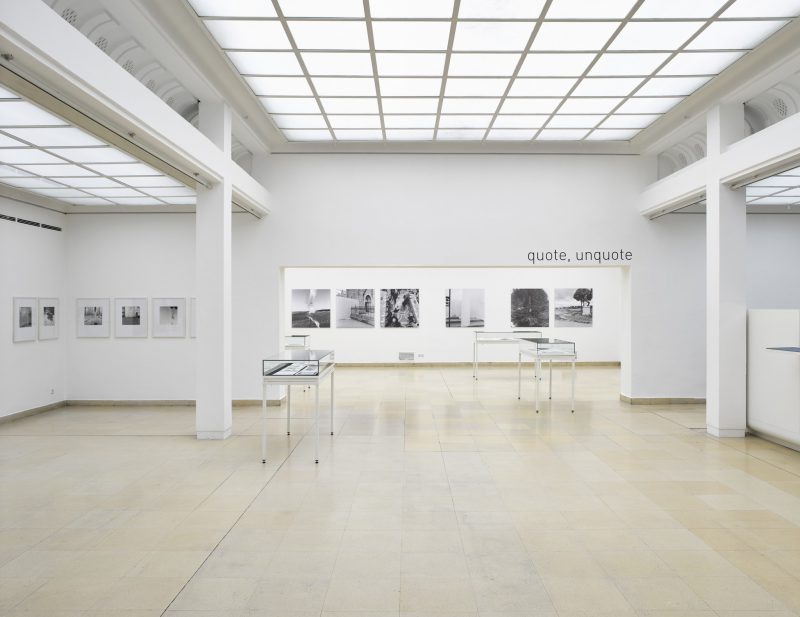
“For here, on those levels between the Alps and the Kattegat, the English Channel and the Urals, touching on the past in any way re-opens a wound still fresh (…)”, from: Ein deutsches Tagebuch, Stefan Chwin, Berlin, 2015
Starting from a period of research in Northern Ireland in the vicinity of Hotel Europa in Belfast, which is famous as the most bombed hotel in the world, and on the tracks of the old and new Europe during a residence in Rome 2015/16, Zita Oberwalder developed the exhibition quote, unquote. The analogue black and white photo essay about territories, proximities, interim spaces, and lines of flight is supplemented by quotations and sketched diary entries, and poses questions about links between the past and the present. How we would love to forget, to black out the past and turn over a clean, white sheet. Each one of us knows this longing. It is shattered abruptly by events such as the terror attack in Paris on 13th November 2015. On the Piazza Farnese in Rome, people remember the victims, laying down flowers as a sign of solidarity and sympathy. As private individuals, we are always ensnarled in world affairs.
“The exhibition is a small collection of short stories and one long sentence,” the artist says, describing the basic concept of the show in the Kunstpavillon. Four display cases containing, besides labels with descriptions of the photos hanging on the walls, a collection of sketches – hand prints and diary notes –, additional unframed photos, and quotations. These cases represent the four narrative threads of the exhibition and provide information about the artist’s chains of associations: The garden of the blind, Hotel Europa, The long sentence and Proximities.
In the chapter The garden of the blind Zita Oberwalder starts out from part of the botanical gardens in Rome, which provides signage in Braille for blind and visually impaired people. Images actually taken there are brought together with others for which the title has a metaphorical meaning. Formal analogies also play their part in this combination: flecks of light, and the spray reminiscent of snowy fields that washes around the fascinating formations of basalt pillars at the “Giant´s Causeway” in Northern Ireland, a sea of glowing autumn leaves from the ginko tree, or white, limewashed tree trunks beside a single trunk embellished with a spotted banderole. In the display case, by contrast, we encounter almost black photographic sketches. Here, Light up Moses is an excellent example worth highlighting. Zita Oberwalder did not, for example, photograph the famous statue by Michelangelo, which Sigmund Freud also studied during a stay in Rome in 1913, but the slot machines where one has to pay to illuminate the masterpiece, which the artist obviously did not do.
Hotel Europa in Belfast, which gives its name to the second chapter, only appears towards the end of the image sequence. It is clear that Zita Oberwalder takes photos while travelling; nevertheless, she is far from being a travel photographer in search of postcard motifs. She quietens the Hotel Europa, so to speak, by use of a detail image taken at the grand piano in the lobby. Reflections of the ceiling spots on the piano and flower vases suggestive of candles conjure an almost contemplative place. Hotel Europa is definitely a political series, which raises questions about the drawing of borders and territories with its perspective on the apparently secondary, the in-between, beyond the aesthetic of news reporting. On 13th November 2015 the artist travelled to Ostia in the footsteps of Pier Paolo Pasolini, taking the photograph of a younger, dark-haired man in a camouflage shirt, leaning on a balustrade and looking out to sea – quiet, perhaps filled with longing. On a post in the picture foreground, we can make out the word “DANGER” on an already weathered sign. Is it the irony of fate that, on the same day, 150 people died in the terror attack on the Parisian concert hall Bataclan? In the display case, among other things, there is a backlit photo showing the latex print of a forearm. The articifial, translucent hand seems to be burning. Is it legitimate to see associations with the hand of God as shaped by Christian iconography?
The long sentence consists of seven large-format prints on Aludibond and a five-part series of small-format vintage prints entitled The photograph as a walker, which describes Zita Oberwalder’s artistic method, showing how she explores places literally while walking. A white flag flutters in the wind, people seen from a bird’s-eye-view move across a mosaic floor around set tables, and a presumably temporary wall docks onto a church. The last image was taken in Belfast and for Zita Oberwalder it visualizes the conflict, enduring more than 30 years now, between Protestants and Catholics, and the uncertainty about how long peace will last. Attentive exhibition visitors notice that the feeding of the poor, which always takes place in the Basilica Santa Maria in Trastevere (Rome) on 25th December, has been a theme already, in the the display case belonging to the Hotel Europa series. The artist interlocks her stories, and so Eisenkappel, a spa town on the border of Carinthia and Slovenia, and the trapdoor connecting the Oratorium with the Bibliothek Vallicellana (Rome) so that it is possible to hear the music in the reading room, also appear in two chapters of the photo essay. All the photos were taken between 2012 and 2016. Dostoyevsky is the only older work, dating from the year 2008. This photo of the strangely antiquated looking memorial first erected in Dresden in the presence of Federal Chancellor Angela Merkel and President Vladimir Putin in 2006 was shown then by Zita Oberwalder in combination with a quotation from Henri Cartier-Bresson: “The purpose of seeing is not identification but penetration.” Here, she uses Dostoyevsky as a self-citation. quote, unquote is also the title of the exhibition. It conveys a possibility as well as an impossibility: the possibility of increasing attention with quotations, using them to underline one’s own initial ideas, or respectively, using quotations as a trigger to ideas at the beginning of a story. “Quote” and “unquote” are words actually used only in spoken language. In written language, they are replaced by quotation marks. The artist reveals much about her methods with this title, about her handling of literary sources, and at the same time, she makes clear the fragmentary and subjective nature of any writing of history.
The fourth chapter Proximities, which is restricted to the space of a display case, marks a break in the work. Here, Zita Oberwalder – for whom the analogue technique and black and white developing in the darkroom are so important because she sees a window of time emerging in the process – picks up a compact digital camera and takes colour photos. The Islamist-motivated terror attacks in Paris on 13th November 2015 also had an effect in Rome, the centre of Catholicism, where people were in a state of shock. They laid down flowers in front of the French embassy on Piazza Farnese and so remembered the victims. To respond to this situation, the artist adopted the documentary means of digital colour photography. Beside a text quotation from the book ”Räume, Orte, Grenzen: Auf dem Weg zu einer Soziologie des Raums”, Suhrkamp Verlag, 2005, p. 74f, by Markus Schroer, there is also a work by her neighbour, artist E.d Gfrerer, with whom Zita Oberwalder often cooperates. He is stretching out a hand to her – and now, in the exhibition, to the viewer as well – through the gap in a skylight window; this is blown up in the traditional perspective of importance. Should this citation of the work by her friend and fellow artist be seen as a symbol of solidarity and cooperation, as a means of mastering times of crisis?
Ingeborg Erhart
